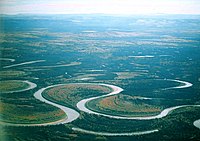
Photo from wikipedia
Sediment supplies are a fundamental component of alluvial river systems, but the importance of sustained supplies of externally derived sediments for the evolution of meandering planforms remains unclear. Here we… Click to show full abstract
Sediment supplies are a fundamental component of alluvial river systems, but the importance of sustained supplies of externally derived sediments for the evolution of meandering planforms remains unclear. Here we demonstrate the importance of sediment supply in enhancing the growth of point bars that influence the rate of sinuosity increase through flow deflections in meander bends. We use an archive of Landsat images of 16 meandering reaches from across the Amazon Basin to show that rivers transporting larger sediment loads increase their sinuosity more rapidly than those carrying smaller loads. Sediment-rich rivers are dominated by downstream-rotating meanders that increase their sinuosity more rapidly than both extensional and upstream-rotating meanders. Downstream-rotating meanders appear to establish larger point bars that expand throughout the meander, in contrast to extensional meanders, which have smaller bars, and upstream rotating meanders, which are characterized by deposition over the bar head. These observations demonstrate that the size and position of point bars within meander bends influences flow routing and thus controls the dominant direction of meander growth. Rivers with low sediment supplies build smaller point bars, which reduces their capacity to increase meander curvature and the resulting sinuosity.
Journal Title: Geology
Year Published: 2019
Link to full text (if available)
Share on Social Media: Sign Up to like & get
recommendations!